Worksection has been on the market for over 16 years, and during this time the platform has proven itself as a reliable tool for task and project management. It is used by teams from different spheres — from marketing and IT to architectural offices and manufacturing companies. Its ease of use, clear interface, flexible task structure and built-in analytics have made Worksection the choice for more than 1,600 businesses.
However, many companies are faced with tasks that require more specialization or additional features. That’s why the project management market offers a wide range of platforms, each of which closes the particular needs in its own way. They answer the question of where to go with Worksection to achieve your business goals.
In this piece, we’ve compiled 10 relevant alternatives to Worksection that may be a good fit depending on the specifics of your work. This is not a review of competitors, but of market peers — platforms that each cover a specific need and may be the right option for your team.
Why are users looking for alternatives to Worksection?
Choosing the right project management tool has a direct impact on team productivity. Worksection offers a balanced and versatile functionality suitable for most tasks. Especially for small and medium-sized teams that need to organize work processes quickly and without unnecessary complexity.
That said, there remain companies that are looking for Worksection analogs because of the following factors.
Narrowly specialized processes
One of the reasons for looking for a Worksection alternative is the need for specific tools. For example, technical teams working on sprints often favor systems with full support for Agile methodologies.
In Jira, you can customize backlogs, sprints, bug tracking, and automatic task allocation rules. These features are important for development teams that need to keep a clear eye on the stages of product development.
Sales team management
Sales teams often look at full-blown CRM systems rather than task management tools. They need to manage the sales funnel, track customer interactions, handle leads, and capture calls. For such purposes, Worksection may seem insufficient, as its main specialization is project management.
Worksection also supports integrations with popular CRM systems: Pipedrive, HubSpot, KeyCRM and NetHunt. This allows you to link task management with client data. However, if CRM is the core of your daily work, it makes sense to consider Zoho CRM or other analogs.
Integrations with external services
Worksection offers an API and support for Zapier, which allows you to customize the integrations you need. But for many teams, the ability to connect other services without additional customization is important.
If the business needs everything to work from the start, platforms with built-in integrations are the way to go. This approach speeds up work and reduces the risk of errors.
Solution for large corporations
Large companies and corporations need advanced role customization, tiered access, reporting, and multi-language support. In addition, these businesses need the convenience of working with large amounts of data and projects in different time zones.
Worksection is oriented rather on small and medium-sized businesses, where simplicity, speed and clear logic of tasks are important. For large-scale structures, solutions that are originally designed to work with dozens of departments and hundreds of users are better suited.
In general, the search for alternatives to Worksection is a natural desire of companies to find the most suitable tool for their model of work. Worksection itself remains an excellent solution for the tasks of classical project management and daily operational work. But if the project goes beyond the basic processes, it is important for businesses to know what other options are available on the market.
Criteria for choosing a project management system
Choosing a project management platform has a direct impact on team efficiency and process transparency. Below are specific criteria to look for before making a decision.
 Interface and ease of learning
Interface and ease of learning
If your team includes employees with no technical experience, the platform interface should be easy to understand at a glance. It’s important that new members can quickly understand the task structure and navigation. Pay attention to the presence of tutorial videos, hints within the interface and an adapted mobile version — this will speed up the adaptation of the team.
 Tools for teamwork
Tools for teamwork
Make sure the platform allows you to leave comments under tasks, use @mentions, attach files, track change history and receive status notifications. This eliminates the need to constantly switch to email or messengers and makes your workflow more organized.
 Integrations with other services
Integrations with other services
Having built-in integrations with Google Workspace, Slack, Zoom, Trello, CRM systems, and cloud storage saves you time and frustration. If your team frequently uses external services — check if the platform has a Zapier or open API to set up data sharing automatically.
 Cost and rates
Cost and rates
Compare not only the price per user, but also the features included in the tariff. Sometimes it seems like the platform is cheap, but you have to pay extra for basic things (time tracking, reports, or access to a Gantt chart). It’s especially important to consider these details when scaling: how does the price change as the team grows? Are there hidden limits on the number of projects, tasks, or files?
 Flexibility and scalability
Flexibility and scalability
Today you have a team of 10 people, a year from now you’ll have a team of 50. Make sure the system you choose can handle this growth. Check if it supports multi-level project hierarchy, grouping by department, customization of roles and permissions. Having task templates and the ability to automate workflows will also be a big plus.
 Adaptation and specialization
Adaptation and specialization
If you work in IT, marketing, manufacturing, logistics, or construction, it’s better to choose a platform that is customized for your industry. For example, IT teams need Agile features and bug-tracking, marketers need visual boards and timelines, and production teams need accurate resource-based planning. Universal systems are good for general process organization, but specialized solutions will save time and provide more value.
When choosing a platform, you should not chase a big name. It is better to test 2 – 3 suitable solutions in practice and evaluate how well they fit into your team, culture and business goals.
The best alternatives to Worksection in 2025
Depending on the tasks and work format, companies may need a platform with a different focus — more automation, flexibility or visual tools. In this section, we’ve gathered Worksection similar programs that are seen as worthy alternatives in 2025. Each offers a different approach to organizing work and may be the best project management tool for a particular team or industry.
Asana
Asana is a tool for teams that need to manage multi-level projects with a large number of participants. The platform makes it easy to coordinate work across departments, track deadlines, dependencies, and prioritize tasks. It is particularly well suited for medium to large sized businesses where clear structure, a high degree of automation and flexible reporting are important.
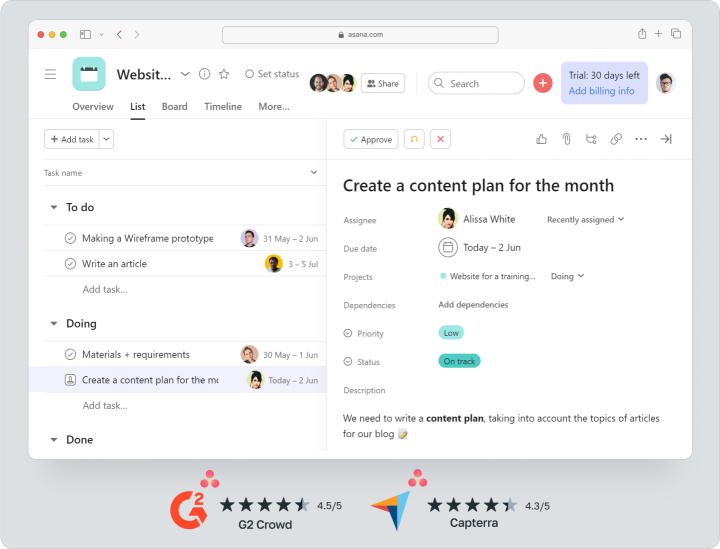
Asana provides advanced capabilities, from KPI tracking to complex team collaboration schemes. Asana’s strength is the visualization of processes through different mappings (list, kanban, calendar, timeline) and the flexibility to automate repetitive activities.
| Cost | There is a free plan | Pricing starting at $10.99 per user per month |
Key features
- Different ways to display tasks: timeline, list, board, calendar.
- Built-in automation: create rules, reminders, assign actions under certain conditions.
- Reports and analytics: tracking progress, team utilization, goal fulfillment.
Pros and cons.
Advantages:- Variety of task display (board, list, timeline).
- Integrations with more than 200 services.
- Ability to automate workflows.
- Can be too expensive for startups and teams with limited budgets.
- Requires time for implementation and customization.
Worksection offers 24⁄7 support from product experts to help with all stages of product integration.
ClickUp
From IT and marketing to operations and product management, ClickUp is a versatile task and project management platform. ClickUp offers an advanced feature set aimed at advanced users and teams who value customization.
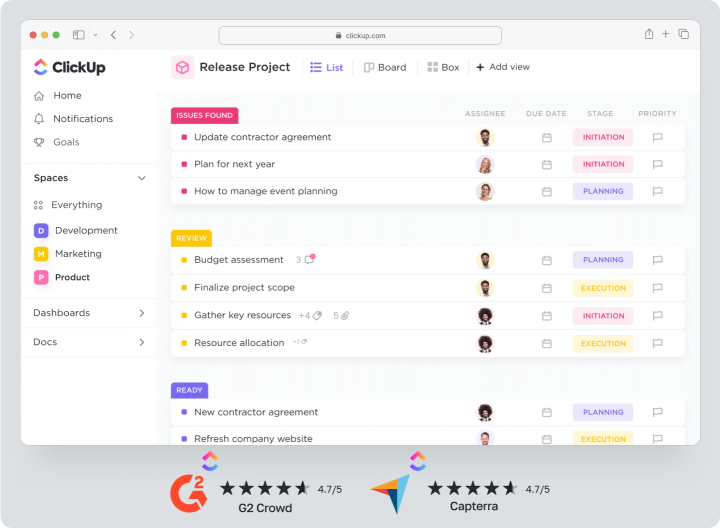
ClickUp is especially appreciated by technical and cross-functional teams who need their own templates, custom fields, automation and reports. You can not only manage tasks, but also maintain documentation, create charts, track time, use mind maps, and even embed your own knowledge bases. This versatility makes the platform interesting for companies that want to create a unified digital work environment.
| Cost | There is a free plan | Price starting at $7 per user per month |
Key features
- Level structure: account → project → list → task → subtask.
- Flexible templates and automation: rules, triggers, actions by condition.
- Detailed analytics: reports on performance and deadline fulfillment.
Pros and cons
Advantages:- Customization for different work scenarios.
- Built-in workflow and note-taking tools.
- Support for Agile, Scrum, Kanban and other methodologies.
- Extensive functionality can be difficult to grasp, especially for new users.
- May take time to adapt and train the team.
Monday.com
Monday.com is a flexible project, task, and operations management tool suitable for different teams, from marketing to development to HR. The platform allows you to customize your workspace for specific purposes using boards, columns, statuses, and automations.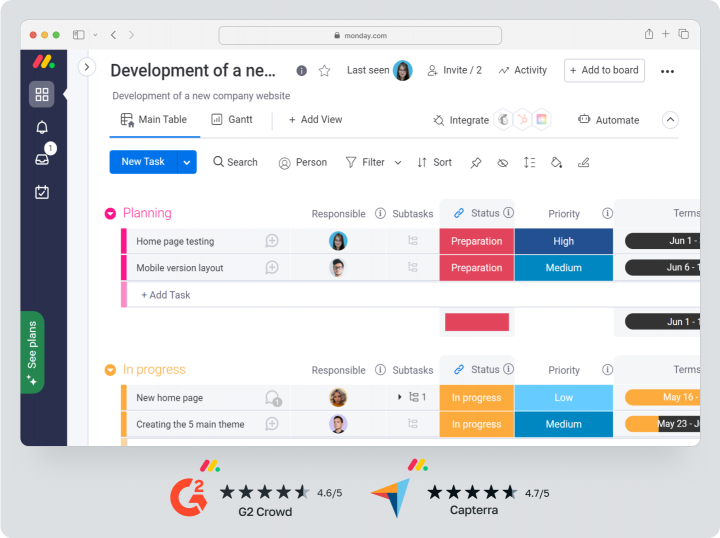
This Worksection analog offers a universal visual approach: the user chooses how their workflow will look like. This is convenient for companies that find it important to customize the system without the help of developers. At the same time, implementation requires time and understanding of the platform logic, especially in large teams.
| Cost | There is a free plan | Price starting at $9.8 per user per month |
Key features
- Customizable boards and templates: The ability to create a structure for any business process.
- Workflow automation: Performing actions when specified conditions occur: notifications, moves, status changes.
- Visual representations: Kanban, Gantt chart, calendar, tables and forms.
Pros and Cons
Advantages:- User-friendly visual interface.
- Quick customization and scalability.
- Rich selection of templates and scripts for automation.
- Cost on pro plans can be too high.
- May not be suitable for technical teams who need specific Agile tools.
Trello
Trello is an intuitive kanban board task management tool. It is ideal for small projects and teams that need to visualize their workflow without complex customizations. Due to its simplicity, Trello is actively used in marketing, training, content management and startups.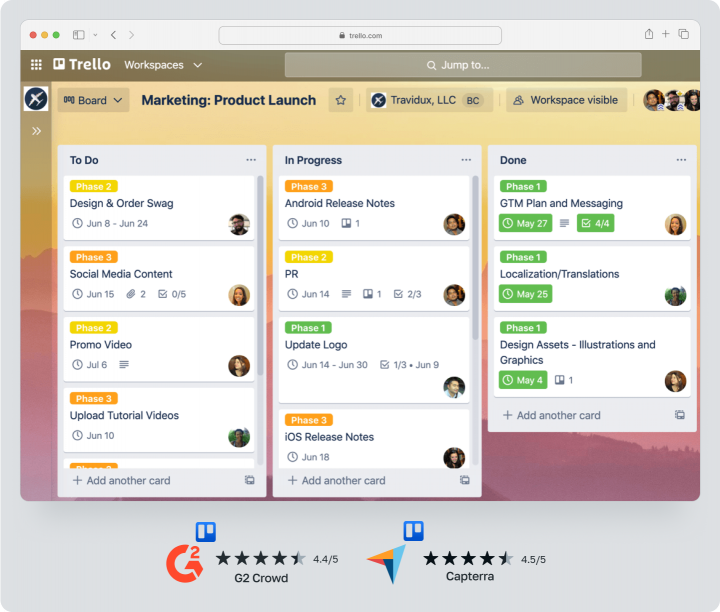
Trello emphasizes visual simplicity and a flexible card structure. Users add their own checklists, deadlines, participants, and tags, making the system versatile but rather limited in scalability.
| Cost | There is a free plan | Price from $5 per user per month |
Key features
Kanban boards and task cards — easy project management via drag and drop.
Checklists, deadlines, tags, participants — flexible card design.
Power-Ups integrations — extend functionality through add-on modules.
Pros and Cons
Advantages:
- Easy start — no training required.
- Convenient for visual control of tasks.
- Free for basic use.
- Not suitable for complex projects.
- Dependence on Power-Ups to expand capabilities.
Worksection functionality is fully available on all plans. Therefore, there is no need to overpay for additional plugins.
Wrike
Wrike is a platform designed for large companies and distributed teams where it is important to manage multiple projects, departments and task flows at once. It offers extensive process customization, time tracking, and analytics capabilities, making it particularly sought after by corporations, agencies, and manufacturing organizations.
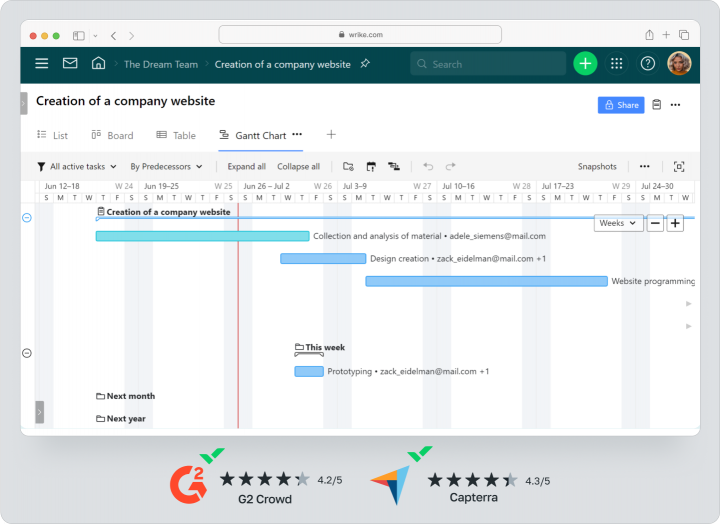
Wrike is focused on structured and large-scale work. It is a platform with advanced features and implementation requires time and internal expertise.
| Cost | There is a free plan | Price from $10 per user per month |
Key features
- Multi-level structure of projects and tasks with flexible hierarchy and statuses.
- Real-time reports and visual dashboards to analyze performance.
- Tools for planning and resource allocation between teams.
Pros and Cons
Advantages:- Flexible process customization for different departments and projects.
- Convenient reports and analytics for management.
- Support for real-time collaboration.
- Interface is complicated for new users.
- Full functionality is available only on pro tariffs.
Jira
Jira is a specialized platform for software development teams, aimed primarily at technical professionals. It offers deep support for Agile processes such as Scrum and Kanban, as well as tools for release planning, backlogging, and performance analysis.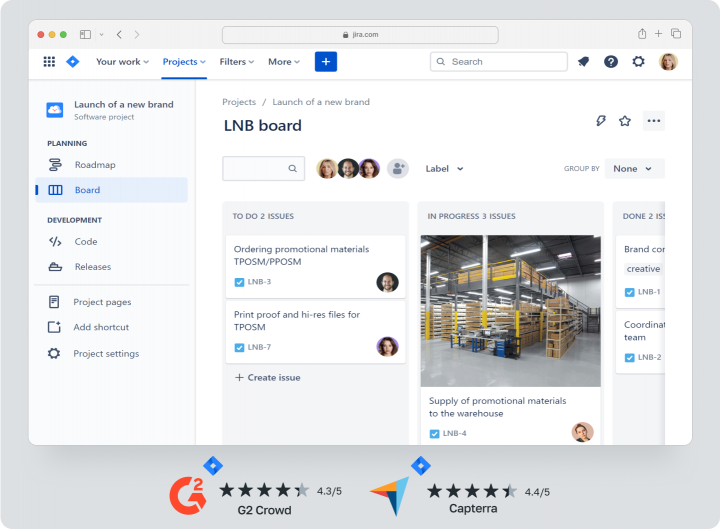
Jira takes time to implement, customize, and support, but provides a high level of flexibility and control over the task lifecycle. It’s not a one-size-fits-all solution, but is tailored for developers, DevOps, and product teams who need to track sprints, git integrations, and manage tasks in detail.
| Cost | There is a free plan | Price from $8.15 per user per month |
Key features
- Agile and Scrum support: boards, sprints, task history.
- Bug tracking: conveniently capture, assign and track bugs.
- Deep analytics: reports on teams, velocity, deadlines.
Pros and Cons.
Advantages:- Flexibility in customizing workflows.
- Wide integration capabilities with other Atlassian products.
- Excellent choice for IT teams and developers.
- May not be suitable for non-technical teams.
- Requires administration and technical knowledge.
Notion
Notion is a flexible platform that combines task management, record keeping, knowledge bases, and project templates in one space. The tool is especially popular among creative, content and design teams who not only need to plan tasks, but also store ideas, presentations, media content and internal guides in a single structure.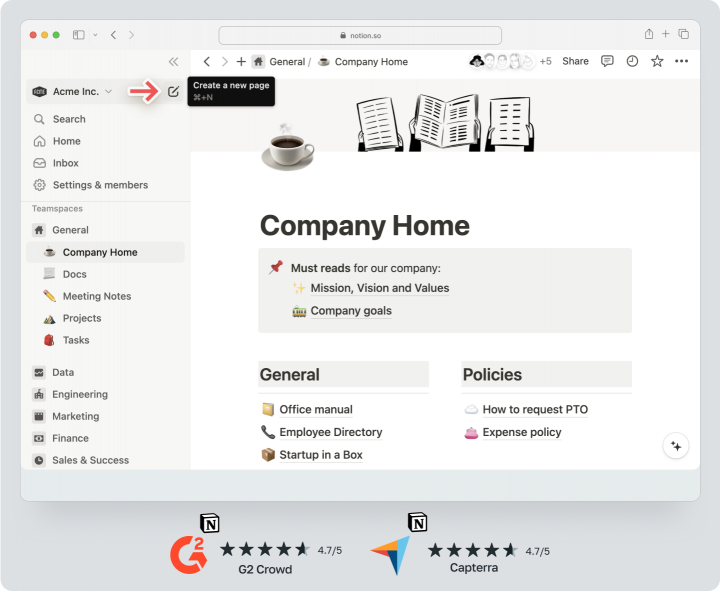
Notion is first and foremost a tool for organizing information rather than a classic task manager. Here you can create flexible workspaces, use templates and customize tables, boards and task lists manually. However, it is precisely because of its flexibility that Notion can seem difficult to get off to a fast start. It will take time and experience to set up an effective structure.
| Cost | There is a free tariff | Price from $10 per user per month |
Key features
- Block editor for creating any type of content, from texts to databases.
- Workspaces and templates for maintaining projects, wikis, notes.
- Flexible view system: gallery, table, board, calendar.
Pros and Cons
Advantages:- Versatility — one tool for tasks, notes, content.
- Support for real-time teamwork.
- Aesthetically pleasing and clean interface.
- Requires manual customization of structure.
- Lacks built-in reporting and charts. Unlike Worksection, which has built-in reporting with the ability to export data.
Basecamp
Another replacement for Worksection is Basecamp, a minimalistic tool for small teams that value ease of communication, centralized task management, and transparency. Basecamp offers a limited but very easy-to-use workspace: each project is a list of tasks, discussions, files and calendars.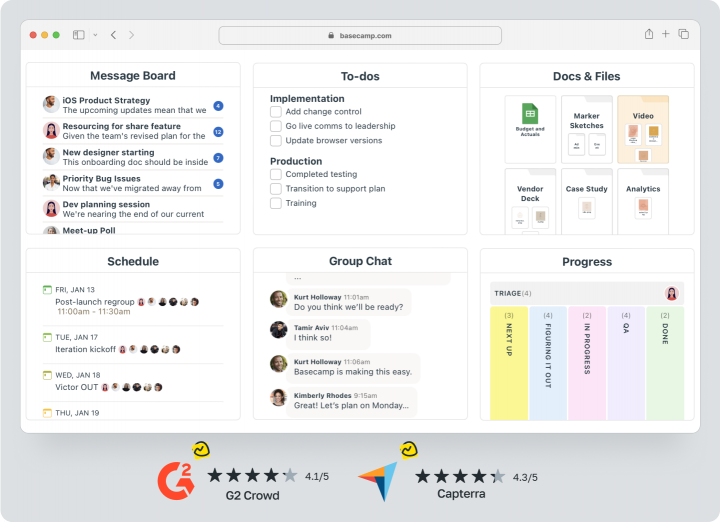
The platform emphasizes communication within the team, facilitating correspondence, reminders and quick file sharing. It’s a great choice for startups, agencies, and freelance teams that don’t need complex scheduling or powerful reporting. But for large-scale projects and company growth, Basecamp’s capabilities may not be enough.
| Cost | There is a free plan | Price starting at $15 per user per month |
Key features
- To-do lists for assigning tasks to projects.
- Client access — you can connect external participants.
- Built-in chats and project messaging.
Advantages:
- Intuitive interface.
- Emphasis on transparent communication.
- Quick start without customization.
- Lack of detailed reporting.
- Not suitable for large teams.
Zoho Projects
Zoho Projects is part of Zoho’s vast ecosystem of CRM, finance, HR tools, and analytics. This tool will be especially useful for companies that are already using other Zoho products, as it allows them to centralize their work and reduce the number of integrations.
In terms of functionality, Zoho Projects offers a complete project management system, including task management, time tracking, task dependencies and reports. The platform emphasizes interaction with other services and deeper automation.
| Cost | There is a free plan | Price starting at $4.3 per user per month |
Key features
- Gantt charts and dependencies between tasks.
- Time tracking and cost accounting by project.
- Integration with Zoho CRM, Desk, Analytics, Mail and other services.
Pros and Cons
Advantages:- Works perfectly within the Zoho ecosystem.
- Supports automations, reporting and notifications.
- Extensive customization options for business processes.
- Without using other Zoho products, some of the benefits are lost.
- Training new employees takes time.
MeisterTask
MeisterTask is a minimalistic yet functional task management platform that emphasizes visuals and ease of use. Perfect for small teams that need a lightweight and intuitive tool for daily work.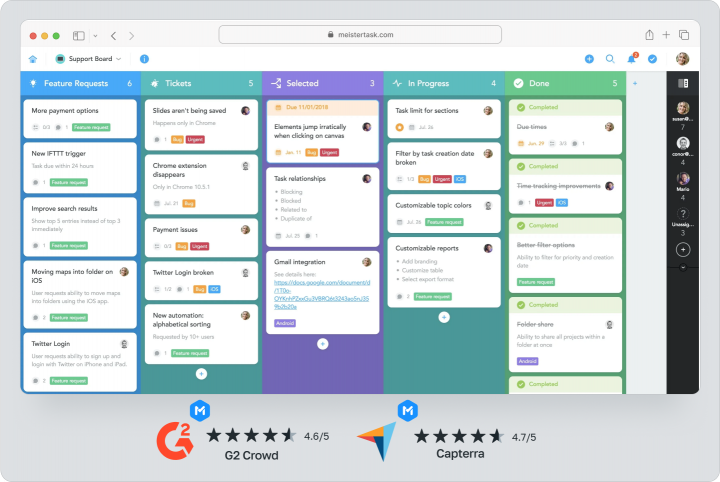
MeisterTask is similar to Trello in structure, but offers a more modern interface, better automation management and built-in timers. MeisterTask prioritizes simplicity and speed of interaction.
| Cost | There is a free plan | Price from $7 per user per month |
Key features
- Kanban boards with color coding and statuses.
- Trigger-based task automation.
- Integrations with Slack, GitHub, Google Drive, MindMeister.
Pros and cons.
Advantages:- Clean and visually pleasing interface.
- Convenient for distributed and creative teams.
- There is a mobile app with full functionality.
- Not suitable for complex and large-scale projects.
- Limited reporting capabilities.
Comparison table of the best alternatives to Worksection
Below is a table with the main features of popular solutions that could become the alternative to Worksection in 2025.| Name | Optimal team size | What tasks it is suitable for | Minimum price per user |
Asana | Medium to large teams | Project management, cross-functional coordination | From $10.99 |
ClickUp | Small to large | Universal task management, Agile, custom processes | From $7.00 |
Monday.com | Small to Medium Teams | Marketing, creative, sales, operations management | From $9.8 |
Trello | Small teams and freelancers | Visual task management, kanban board | From $5 |
Wrike | Medium and large teams | Complex projects, work across multiple departments | From $10 |
Jira | IT and technical teams | Software development, Agile, sprints, bug tracking | From $8.15 |
Notion | Creative and cross-functional teams | Knowledge bases, documents, collaboration | From $10 |
Basecamp | Small teams and agencies | Team collaboration, basic task planning | From $15 |
Zoho Projects | Medium and large teams | Project management in Zoho ecosystem | From $4.3 |
MeisterTask | Small and creative teams | Visual planning, quick tasks | From $7 |
Which platform to choose in 2025?
When choosing a project management tool, it’s important to realize that different platforms solve different problems. There are enough solutions on the market for every team to find a tool that fits their work rhythm, communication format, and business goals. For this purpose, it is important to look at how the functionality of the service fits into your processes.
If you’re an IT team, Jira is likely to be a good fit. It’s a highly specialized platform tailored to technical processes. It is convenient to run sprints, work with the backlog, track bugs, link to Git, and plan releases. But Jira requires technical training and time to implement.
If you work in an agency or are involved in creative projects — take a closer look at Trello or MeisterTask. These Worksection analogs are ideal for visual planning of small projects. It’s easy to reprioritize, drag and drop cards, lead discussions, and connect clients on the fly. But as the team grows and the number of tasks grows, this format can start to “break down” — it lacks structure and accountability.
Teams that focus on customization and automation often choose ClickUp or Monday.com. These are platforms where you can build everything from tasks to CRM. But with increasing functionality comes complexity, and to utilize the features 100%, you need time to master them.
In such conditions, Worksection finds itself in a winning position for small and medium-sized businesses. This platform combines simplicity, clear interface and everything necessary for managing tasks, projects and time: kanban, Gantt, time-tracking, reports, roles. There’s no clutter, and most importantly, you don’t have to spend weeks on implementation. You create a project, add tasks and start the process literally the same day. That said, if you need more — you can always plug in integrations with Pipedrive, HubSpot, Telegram or Google Drive.
Worksection is the best option for processes where transparency, control and convenience in one system are important. Whether it’s an agency, production, consulting or a team of 10 people. Pricing starts at $3.4 per user per month, making the solution one of the most affordable in terms of price to functionality.
Bottom line, if you need not just a simple task manager, but a complete tool for your entire team with the ability to grow and scale — Worksection will be a solid choice.
Frequently Asked Questions (FAQ)
What is the best Worksection alternative for small businesses?
If you are interested in Worksection analogs for small teams, you should consider Trello, MeisterTask and others. These platforms are easy to use, quick to learn and suitable for startups, freelancers and small teams.
However, it is important to keep in mind that most of these solutions lack built-in analytics tools, Gantt chart, and time tracking. They are added through extensions or are not supported at all. Worksection, on the other hand, offers comprehensive functionality even at the basic tariff and allows you to develop with the growth of your team.
Are there free analogs of Worksection?
Yes, there are free solutions with basic functionality on the market: ClickUp, Asana and Notion offer free plans for small teams. Most of them are limited in the number of users, projects or features.
Worksection also offers a free plan designed for small teams of up to 5 people. It includes basic task management, which will be enough to get you started without investment.
How does ClickUp differ from Worksection?
ClickUp offers a very wide range of features: multi-level task structure, knowledge bases, documents, reports and various automation scenarios. This makes the platform interesting for large teams and corporations
Worksection relies on simplicity, speed of implementation and clear task logic. It is perfect for small and medium-sized teams who want to access the basic project management features: tasks, roles, reports, time tracker and integrations.